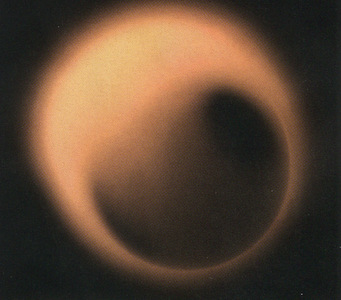Our Magnetic black hole:
Astronomers have detected magnetic fields writhing around the Milky Way's central black hole.

Strong gravity bends light around the Milky Way's black hole in this simulation, leaving a silhouette against a glowing background.
Abraham Loeb & Avery Broderick
Abraham Loeb & Avery Broderick
Astronomers are on a quest to see a black hole. It’s not as quixotic as it sounds. Despite their reputations, black holes are lousy cosmic vacuums: they suck up only a fraction of the gas in the accretion disks that gird them, flinging around or ignoring the rest. It’s these glowing disks of gas that undermine the beasts’ innate stealth. The black hole’s extreme gravity bends light from the disk around its boundary and creates a telltale silhouette — the “shadow” of the event horizon, the point of no return.
At least, that’s the idea: we haven’t seen this shadow yet. But the Event Horizon Telescope aims to do it. The EHT is a world-spanning project linking together radio antennas from Hawai‘i to the South Pole to work together as a gigantic, planet-size virtual telescope called an interferometer.
As part of that endeavor, Michael Johnson (Harvard-Smithsonian Center for Astrophysics) and other members of the EHT collaboration have now used a mini version of the growing network to watch magnetic fields dance in the skirts of our galaxy’s central black hole, Sagittarius A*.
Magnetic Fields Run Amok

This artist’s conception shows Sagittarius A*, the black hole at the center of our galaxy, surrounded by a hot disk of ionized gas. Blue lines trace magnetic fields. Astronomers using the Event Horizon Telescope have measured our black hole's magnetic fields for the first time, resolving structures as small as 6 times the size of the event horizon (6 Schwarzschild radii). The fields are disorderly and changeable, like intertwined spaghetti. The fields the team found are either in the disk or the jet (if the black hole has one — astronomers don't know).
CfA / M. Weiss
CfA / M. Weiss
The astronomers used telescopes in Hawai‘i, California, and Arizona, their observations synched with next-gen atomic clocks, to peer into the black hole’s inner sanctum. With only three sites and a few nights’ worth of observations, they couldn’t reconstruct a complete image — instead of seeing the whole elephant, what they’re seeing now is more like an ear and a bit of trunk.
But those bits are good enough for them to start detangling what’s going on.
The team detected what’s called synchrotron radiation. Synchrotron radiation is polarized — similar to light reflected as glare off a lake — and it’s created by electrons corkscrewing along magnetic field lines. But this polarized emission wasn’t steady: it varied in amount and direction, and quickly, on roughly 15-minute time scales.
If the polarized emission is changing, that means the magnetic fields themselves are moving around, which in turn means that the gas the fields interweave is moving, too. In fact, it looks downright turbulent.
These changes only appear very close to the black hole. So essentially, the astronomers are seeing tangled, turbulent magnetic fields cavorting right near where gas takes its final plunge in past the event horizon.
The observations reveal structures on a scale that’s only a half dozen times the size of the black hole’s radius, the team reports in the December 4th Science. To be able to detect these motions and changes at this scale is “really just amazing,” Johnson sums up.
Bringing Theory to Life
This result is great news for theorists, says Chris Reynolds (University of Maryland), who has spent his life working on black holes. It’s taken decades to understand why gas in the accretion disk falls into a black hole at all — it should just orbit forever, because the gas is too tenuous for friction to slow it down.
Astrophysicists finally realized a couple of decades ago that magnetic fields swirling around in the accretion disk would tug on the gas, pumping up the turbulence and robbing the gas of its angular momentum, allowing it to fall into the black hole.
“But it’s all been very much in a theoretical domain,” Reynolds says. “We believe this is how disks must work, because we don’t have any better ideas.” The new EHT observations show that theorists have been on the right track. “It’s honest-to-goodness measurements of a real black hole that are getting to the crux of this issue.”
For now, the team can’t tell if the magnetic fields are part of a jet or the disk, but it looks like they’re only seeing one or the other, not both, Johnson says. Astronomers don’t know whether Sgr A* has a jet, but in simulations jets often shoot from slow feeders like our galaxy’s black hole, Reynolds adds.
The EHT team has brought two more telescopes into the fold this year, and it’s on track to bring ALMA into the network, hopefully in the next year or two. Once the EHT can construct images, what we learn from the event horizon’s silhouette will doubtless knock our socks off.
-
No comments:
Post a Comment